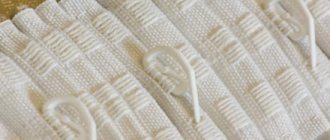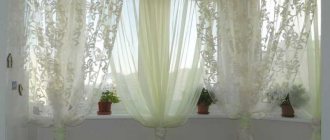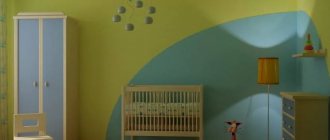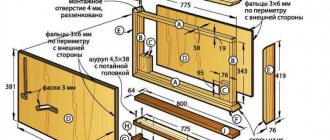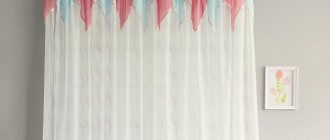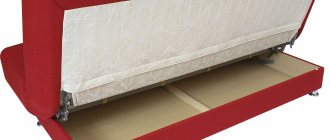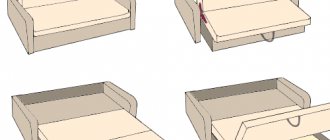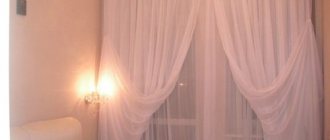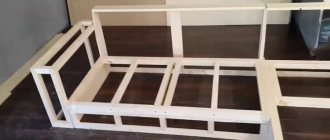Tulle is often chosen to decorate windows. This is a light and weightless curtain that gives a special coziness to the interior. Tulle does not always have the appropriate length. If you decide to hem tulle at home, then you should do this work carefully. This material is quite capricious and requires careful handling. You can hem the tulle by hand or using a sewing machine. In the second case, the seam will be neater. From this article you will learn how to hem tulle yourself at home.
How to align the edges of tulle for cutting and hemming?
Now in all stores and even markets there are points that specialize in hemming curtains and tulles. After all, you usually purchase canvas per meter with a standard height. But, unfortunately, not everyone can boast a ceiling height of 3.2 or 2.9 m. Namely, these values are the standard length of tulle or curtains. Accordingly, the canvas will have to be shortened.
This can be done at home or in a studio. But remember that the work of shortening and sewing the braid can cost from 10 to 25% of the total cost of the tulle. Accordingly, you can save a lot if you do all the work yourself.
Instructions:
- Typically, tulle is made from fabric that frays. Therefore, it is quite difficult to align the edge. But there is another method.
- It is necessary to mark the place where you need to cut and make an incision 2-3 cm long.
- Now just grab the tulle by two edges and tear it. The most interesting thing is that when you tear the tulle, the edge turns out to be perfectly smooth and rounded. It is much easier to hem it later.
- There is another method to align the edges. It is often used by builders to level walls. You need to immediately sew on the braid and hang the tulle on the cornice. After this, a thread is sewn on top and a weight is hung. These marks can be used to cut.
How to align the edges of tulle for cutting and hemming?
Features of the material
Tulle is a lightweight translucent material. It can be made from synthetic or natural fibers. Blended fabrics are especially popular. Since the presence of synthetic threads often makes it easier to care for curtains. So, we have decided on the material, now we need to bring it to “readiness” so that it fits in length and width.
Well-chosen tulle is one of the most important decorations in your kitchen, living room, bedroom or hallway.
What length options are there:
- To the windowsill. Often this length is chosen for children's rooms. This is convenient and helps solve some problems. For example, if a child is crawling on the floor, he will not get tangled in long curtains. And also in the case when older children begin to actively play in their room (hide and seek, catch up, and so on), the curtains will be completely safe. In addition, curtains up to the windowsill are a great idea for the kitchen. Firstly, such curtains will not get too dirty, and secondly, you will have additional space on the windowsill on which you can place the necessary things. Agree, a nice bonus.
- Tulle to the floor. This length is considered classic. The curtain completely covers the wall, and even the baseboard. This option is often used to decorate a window in the living room. Of course, this is not the most practical model, but for some interiors it is simply ideal.
- Standard length. This name was given to curtains whose length is 2 or 4 centimeters above the floor. This is a very functional option. Curtains do not rub against the floor, do not get dirty and last longer.
- Slouchy tulle. Externally, it looks like this: the curtain not only completely hides the wall and baseboard, but also lies on the floor in voluminous folds. Waves on the floor must be laid manually. As a rule, the length of the overlap is 15-20 cm.
Tulle is a light, transparent material.
It can be made from natural fabrics, synthetic, or a mixture of different fibers. It can be cotton, linen, silk and other materials. Important: this model is suitable only for rooms with high ceilings, and is strictly “contraindicated” for rooms with low ceilings. Visually, the product reduces the size of the room.
When modeling and sewing curtains, do not forget about the standards for filling the width of the window opening. There are also rules here. After all, the finished curtain should look impressive and complete.
When modeling and sewing a product, do not forget about the standards for filling width. The finished product should look beautiful and rich.
The minimum proportion for stylish filling is 1:2. This is suitable for both plain curtains and tulle with a large pattern. If you take even less, the curtains will look poor.
Weighting agents are used to give the lightweight material its shape. They are produced in the form of cords or plates. They give the air product a completed look and establish its shape.
The optimal filling of the window opening space is 1:3. Then you are guaranteed rich decoration. And just one nuance: refuse curtains with large patterns, give preference to either a small print at the bottom or plain tulle.
In the design of modern rooms, tulle of various colors and sizes can be used.
How to cut and shorten tulle evenly if it is long?
Nowadays, more and more buyers do not trim curtains, but use a variety of hems. This will allow you to rip off the tape and lengthen the curtains if necessary. But if you do not want to do this, it is advisable to shorten the tulle after it has hung on the curtain rod for 3 days. In this case, the canvas is completely straightened.
Instructions:
- Once your curtains have hung, you can trim them.
- To do this, it is worth considering the features of your room. Often the floor and ceiling are curved, which is why the height of the room is different at certain points.
- In this case, it is worth noting the height at the beginning, at the end and in the middle. After that, print the average value.
- It is advisable to draw a line using a ruler. Often curtains are cut using a stationery knife.
- To do this, the ruler is placed on the curtain and drawn with a knife.
How to cut and shorten tulle evenly if it is long?
What threads should I use to hem tulle?
The most commonly used is polyester. The threads should be thin and match the color of the tulle. Nowadays, hardware stores have a huge selection of threads. Under no circumstances use old cotton threads. They vary in thickness and can cause arrows and puffs to appear. Silk is also often used.
What threads should I use to hem tulle?
How to properly and beautifully hem tulle on top using tape: description, video
Most often, a braid is hemmed on top. This is a wide ribbon with threads and holes for hooks. After the braid is sewn, it is pulled together. This results in a beautiful drapery.
It is best not to cut the length, but to tuck the rest of the fabric on top. After this you can sew on the braid. If desired, the lower part of the fabric flap is hemmed or using binding. Craftsmen often do this, which allows, if necessary, to rip off the braid and lengthen or shorten the tulle. Details in the video.
The simplest pins
This is a very elegant and elementary way. You just need to raise both ends of the curtains so that they reach the middle of the window. To do this, you need to have a thread and a needle on hand. Safety pins for notes also work well.
You need to raise the curtains on both sides until it looks nice. After this, you just need to stick the needles into the folds. If there is a need or desire, then you can also sew it all on, but so that the seams are on the inside. And to make the curtains look even more aesthetically pleasing, you can iron the edges. The reader can see an example of such work in the photo above.
How to hem tulle on the sides correctly and beautifully?
This is not as simple a task as it seems. The thing is that when using ordinary threads, the fabric tightens and the result is not very beautiful. That is why initially it is better to stretch the fabric on the sides as much as possible. There are two methods to do this.
Options for hemming tulle on the sides:
- Break off. You need to make a 2 cm deep cut with scissors and simply tear off a piece of fabric. This way you will get a perfectly straight side. Now you can simply overlock it using silk threads.
- Finish with a double stitch. Everything is done very simply. First, the fabric is folded and stitched. After this, it is folded and stitched again. In this way, wavy and uneven sides are avoided.
How to hem tulle on the sides correctly and beautifully?
Side cut processing
The tulle will also have to be hemmed on the sides. This procedure can be done in several ways: Moscow seam, bias tape, hem. The traditional method is sewing using the Moscow seam. But for a denser fabric, other outsole options can be used.
Hem
This is one of the most versatile methods for processing fabric. It allows you to shorten curtains made of any fiber: both thin mesh and dense. How to hem tulle - step-by-step master class:
- measure the required distance from the edge, tuck it inward. For mesh curtains, it is best to measure 1 cm; on denser synthetic fabrics, measure 3 cm; on veils or nylon, it is better to fold 20–20 mm;
- Sew a line along the intended seam.
You might be interested in Ready-made patterns and instructions for sewing lambrequins for curtains
The curtain must be ironed or steamed and then hung on the window.
Side cut processing
Bias tape
This side seam processing option is suitable for those who want to implement their design solutions. For example, take a fabric that is close in shade to tulle or, on the contrary, more contrasting in color. The binding fabric may be thicker. Some masters advise taking canvases that are used for wall decoration. The combination of such materials will look beneficial in modern interiors. How to make a side seam, step by step instructions:
- take the trim of the desired shade and material, secure it with a pin;
- check whether the pieces of fabric are straight in relation to each other;
- Sew the tulle along the side seam, checking at the same time that it is even.
Note! Bias tape looks stylish on mesh tulle or curtains that have embroidery.
Tulle with bias tape
Moscow seam
The Moscow seam is considered one of the popular types of side cut processing for thin or thick curtains made of synthetic and natural fibers. The order of sewing work is as follows:
- lay the curtain on a flat surface and tuck the side cut by 50 mm;
- iron along the edge of the curtain so that the seam is clearer;
- make a regular stitch, which will retreat 0.2 cm from the edge of the tulle;
- if necessary, trim excess fabric;
- tuck the fabric 50 mm;
- go over it with an iron again;
- make another line, which will be located at a distance of 2-3 mm from the first seam.
This stitching method is suitable for miniature curtains, where minimal fabric is required for sewing work.
Moscow seam
How to properly and beautifully hem tulle with weighting at the bottom?
The tulle is hemmed at the top. There are several options.
Options for hemming tulle with weighting:
- With a fold. The tulle is folded at the top and a fold is made. The bottom of the fold can be trimmed with trim or ribbons.
- Cut off the top. In this case, the excess piece of fabric is cut off and the braid is sewn on top.
- With rings. This option is suitable if you hang the tulle directly on the cornice. In this case, rings are made or ribbons are sewn on.
How to properly and beautifully hem tulle with weighting at the bottom?
How to hem tulle correctly and beautifully without cutting?
To do this, use the method described above. In this case, there is no need to trim anything. The excess piece of fabric is folded outward and stitched at the fold. Next, a braid is sewn close to the fold. However, the lower part of the frill is not very beautiful. It resembles a ripped edge. In this case, this area is hemmed using tape or tape.
How to hem tulle correctly and beautifully without cutting?
External weight for weighting
Instead of filling the inside of the curtain with various elements, you can hang a load from the outside. Then weights with various holes, as well as weights, are used. From available means, such products can be easily replaced with unnecessary worn-out coins. Serially supplied weights are mainly made either round (that’s when holes are needed) or elongated conical parts. Most often, such designs are sewn into spreads from the sides.
To replace cone-shaped weights, balls, flat or cylindrical steel parts are used
To prevent possible contamination, all this is covered with fabric and carefully placed in the side seams. The side hem is slightly cut from the inside
This cut should be 50-60 mm from the bottom line. A load is usually inserted into the hole. When there are no side flaps, the weight must be sewn on using a special tape specifically designed for curtains.
For each type of fabric there are strict standards for cargo weight. So, in tulle and light fabrics, weights should be used no lighter than 13 and up to 23 g inclusive. Lighter ones will not fulfill their task, and heavier ones can tear thin matter. For linen and other types of fabric of moderate density, the standard weight will be 23-50 g. But when using curtains that are sewn from dense materials, 50 g is already the minimum limit.
How to hem tulle correctly and beautifully by hand?
Doing the work manually is not at all easy. But it is still possible to do it. Be patient. If you don’t have a machine and you are not going to take the tulle to the studio, purchase fabric with a weighting agent.
Instructions:
- At the very beginning, the side seams are processed. The tulle is folded over once and sewn with a “forward needle” seam.
- After this, the side tulle is folded again and stitched with exactly the same seam. After the first filing, it is advisable to smooth the fabric. This will completely line up the side seam and it will be perfectly even.
- Next, you need to figure out what to do with the length. The bottom of tulle with weighting cannot be cut off. In this case, you can cut off the rest of the fabric at the top or simply fold it outward. After this, the braid is sewn on, and the bottom of the resulting frill is decorated with trim.
How to hem tulle correctly and beautifully by hand?
How to process the edges of nylon tulle, mesh and organza: tips
If the tissue is very thin, then there may be puffs left at the points where the needle is inserted. This is especially true for sewing machines. To process thin tulles, it is worth purchasing special needles. But you can do without filing at all. Of course, the edges look untidy, but this is easy to fix with adhesive tape.
Instructions:
- This tape is sold in hardware stores and is a paper strip coated with a mesh of hot-melt adhesive.
- You need to cut the edge and fold it, iron it. This is necessary in order to form an even fold and bend.
- Next, an adhesive mesh is inserted, from which you should not tear off the paper. An iron is drawn along the glue line.
- Next, you need to carefully remove the paper, fold the edge and iron it again. Do not use a damp cloth while ironing. Everything should be dry.
- Of course, this method is not the best, since after several washes the glue comes away from the fabric and you have to smooth the edges again.
How to process the edges of nylon tulle, mesh and organza: tips
As you can see, tulle is a beautiful fabric with which you can decorate a room. All work on hemming tulle can be done at home. It is not necessary to use threads.
Using weights
Weights can be different in shape: they can be cylindrical, round, curly, and so on. Some of them are made in the format of mini plates with holes for easy sewing to the curtain. What such a load looks like is shown in the photo below.
The curtain, to which a weight is attached in the corner, maintains an even rectangular shape, and its edges cannot bend. Moreover, the beautiful and sometimes even designer shapes of pendants allow them to be used even as decoration, and thus hide their intended purpose.
Like any other weight, the suspension has its own purpose - to support the fabric panel in a certain position. For example, these kinds of pendants are used to weigh down French curtains. This allows the curtains to keep a more even and smooth shape. For French curtains, weights of various design shapes are used so that they not only fulfill their intended role, but also decorate the finished interior detail.
This is what the “Amphora” weight looks like for a French or Austrian (modified version of the French) curtain:
As can be seen from the information described in this article, the issue of giving window curtains a perfectly even shape is not problematic. Depending on the type of curtain, an appropriate straightener or weighting agent is selected, which, if properly attached and used, will perform its functions
You should choose such accessories based on the specific type of curtain, as well as paying attention to the material that was used to sew this curtain. The lighter the fabric, the lighter the weighting material should be chosen and vice versa
All the fittings that are needed to attach any type of weighting material are sold in the same stores as the curtains and the straighteners themselves. Before purchasing such accessories, you need to measure the width of the fabric and, if possible, weigh it. Having data on the area and weight of the curtains helps you choose the right straightener that will perform its functions.
